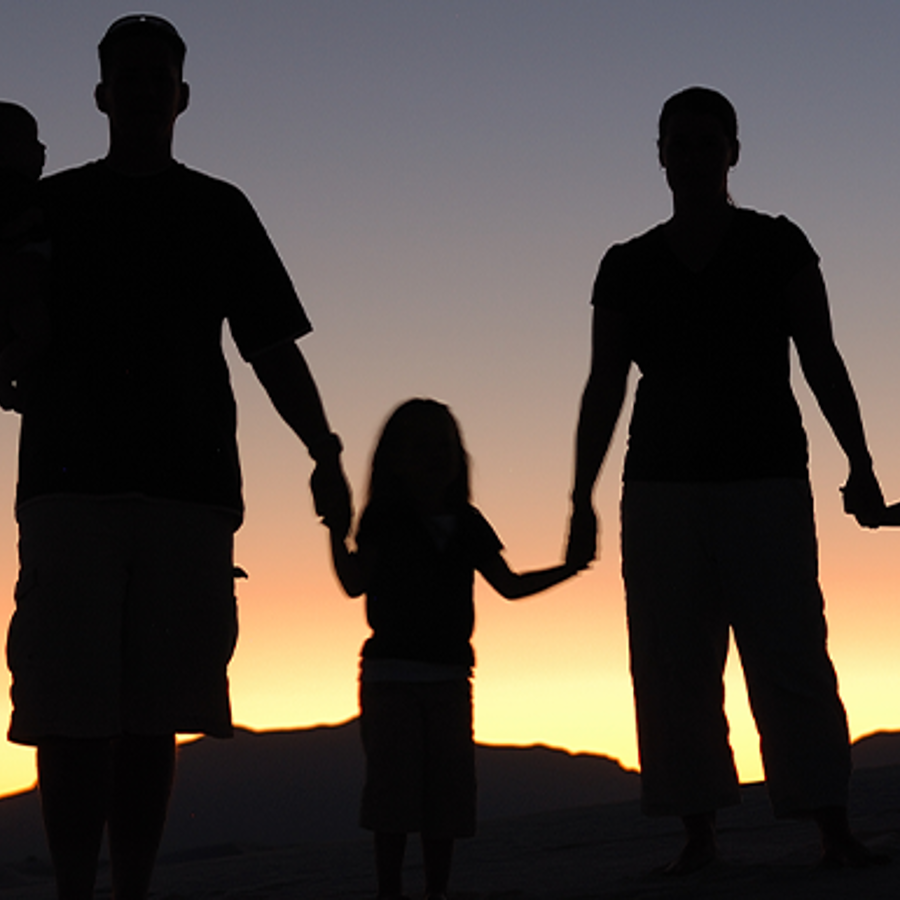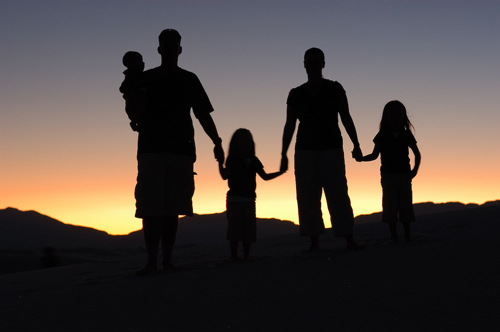
All three of my children are AB negative. Does this mean that I must be Rh negative?
March 8, 2016

- Related Topics:
- Blood type,
- Rh factor,
- Dominant and recessive,
- Carrier
A curious adult from Pennsylvania asks:
"All three of my children are AB negative. Does this mean that I must be Rh negative?"
Not necessarily. You could be Rh negative (Rh-)or Rh positive (Rh+).
This is because Rh- is something called a recessive trait. This means that someone who is Rh+ might have a hidden Rh- in their DNA. If that person and his or her partner both pass an Rh- down to a child, that child will be Rh-. Even though at least one parent is Rh+!
If we knew you were positive-type and the other parent was negative-type, then each child would have a 50% chance for being Rh-.
From this you might think at least 1 of your 3 kids HAS to be Rh+. But this is not the case. There was a 1 in 8 chance of getting 3 negative-type kids.
Think about it like flipping a coin. With a coin, you have a 50% chance for heads and a 50% chance for tails. If you flip a coin twice and get two tails, what are the chances that you will get tails on the next flip? Still 50%.
The coin doesn’t remember what was flipped before. And your body doesn’t know whether it passed down an Rh+ or an Rh- with a previous child.
So you don’t necessarily have to be Rh-. In fact not even the other parent has to be Rh-.
It is possible for both of you to be Rh+ and have three Rh- kids. In this case, the chance that all three will be negative drops to 1 in 64.
For the rest of the answer, I will explain why you can be Rh+ with three Rh- kids. As you’ll see, it has to do with the RHD gene and how it is passed down.

The RHD Gene
Whether or not you are Rh- or Rh+ is decided by the RHD gene. It comes in two versions, or alleles. We’ll call one version Rh+ and the second Rh-. (Click here to learn why this is a bit of a simplification.)
Like most every other gene, we have two copies of the RHD gene. One copy came from your mom and the other from your dad.
If both copies are Rh+ (+/+), it is easy to see why you would be Rh+. That is all you have.
The same is true for two Rh- copies (-/-). In this case you would be Rh-.
But it is less obvious when you have one copy of each (+/-). In this case, you are Rh+ because Rh+ is dominant over the Rh-. Another way to say this is that Rh- is recessive to Rh+.
So to be Rh+ you just need one copy of the Rh+ allele. But in this case you would be carrying a hidden Rh- allele which you could pass down to your child.
|
Rh alleles |
Blood type |
|
+/+ |
Rh+ |
|
+/- |
Rh+ |
|
-/- |
Rh- |
Both Parents Could be Rh+
As I said, we get one copy of each gene from mom and one from dad. So it makes sense that we pass only one copy of each gene down to our kids. Which copy we pass down is random each time we have a child.
Let’s say you are Rh- (-/-). You will always pass an Rh- allele to each child.
Similarly, if you have two Rh+ alleles (+/+), you will always pass an Rh+ allele to each child.
Now instead, let’s say you have one Rh+ allele and one Rh- allele (+/-). You could pass either on to your children.
Let’s look at an example, and say you are Rh+ but carry a hidden Rh- allele (+/-). And that your partner is Rh- (-/-). Your partner will always pass on an Rh- allele, but you could pass on either.
There’s a 50% chance you pass an Rh+. That child would have one of each (+/-, like you!) and be Rh+. And there’s a 50% chance you pass your Rh-. That child would have two negative copies (-/-) and so be Rh-.
In this example, each time you have a child, there is a 50% chance they would be Rh-.
Here are all the probabilities for any parent combination put together into one table:
|
Parent 1 alleles |
Parent 2 alleles |
Rh type of a possible child |
|
+/+(Rh+) |
+/+ |
100% Rh+ (100% +/+) |
|
+/+(Rh+) |
+/- |
100% Rh+ (50% +/+ and 50% +/-) |
|
+/+(Rh+) |
-/- |
100% Rh+ (100% +/-) |
|
+/- |
+/- |
75% Rh+ and 25% Rh- (25% +/+, 50% +/-, 25% -/-) |
|
+/-(Rh+) |
-/- |
50% Rh+ and 50% Rh- (50% +/- and 50% -/-) |
|
-/-(Rh-) |
-/- |
100% Rh- |
This is only an expectation, though. Because the alleles are passed on randomly, there will certainly be cases where all of your children will be Rh- or none will be. It’s up to chance. Like getting three heads in a row when you flip a coin.
Some Groups are More Likely to be Rh-
Since all three of your kids are Rh-, this makes it more likely that you both are Rh-. This isn’t a guarantee, but if I were a betting man, that’s where I would put my money. For sure, it is far more likely for you two to have three Rh- kids if you were both Rh-!
At the very least we know that you and your partner both have at least one Rh- allele. Otherwise, it would be extremely unlikely for any of your kids to be Rh-!
The chances you are both Rh- will also be different depending on where you are from. For example, the Rh- allele is much more common in Europeans than it is in Asians (see chart below).
|
Population |
Frequency of Rh(D) negative allele |
Probability you are Rh- |
Probability you are Rh- |
|
European |
40% |
16% |
72.7% |
|
African American |
26% |
6.8% |
58.4% |
|
Native American |
10% |
1% |
30.8% |
|
Asian |
1% |
0.01% |
3.9% |
The second column shows how common the Rh- allele is in a population. Around 40% of the RHD alleles in Europeans is the negative type.
But this does not mean that 40% of Europeans are Rh-. This number is found in the third column. Around 16% of Europeans have two Rh- copies. (The rest of the Rh- alleles are found in people with one of each.)
The fact that you have 3 out of 3 kids who are Rh- increases the odds that you are Rh- from 16% to 72.7%. This information is found in the final column.
All of that was assuming you were European and that the father was also Rh-. The numbers are different depending on your background. For example, for Asians, knowing the blood group of your children only increases your chances of being Rh- to 3.9%, which is still very small.)
Even with all of this we still cannot say for sure what your Rh type is. We can only say it is more likely you are Rh- because you have had three Rh- children.
Cats and quick reflexes
But why are there so few copies of the Rh- allele? And why does it vary so widely between populations?
There is no clear answer, but there is a very interesting hypothesis involving cats and quick reflexes.
There is a parasite called Toxoplasma gondii that normally infects cats. When this parasite infects humans, it can cause people to react more slowly. Studies have shown that Rh+ heterozygotes (people who carry the Rh+ and Rh- allele) may be resistant to this symptom.

Some scientists think that because of this resistance, the Rh- allele has stayed in the population, even though the Rh- trait can cause difficulties for Rh- women during pregnancy.
Different rates of infection by this parasite may have caused different frequencies of the Rh- allele. For example, the large number of wild cats in Africa and Asia could have raised the frequency of Rh- there.
Although we can’t say for certain that you are Rh-, we can say that knowing your children are all Rh- increases your chances of being Rh- too. To find out your blood type for certain, your doctor can perform a simple blood test.

Author: Joe Davis
When this answer was published in 2016, Joe was a Ph.D. candidate in the Department of Genetics, studying regulation of gene expression in humans in Stephen Montgomery’s laboratory. He wrote this answer while participating in the Stanford at The Tech program.
 Skip Navigation
Skip Navigation
